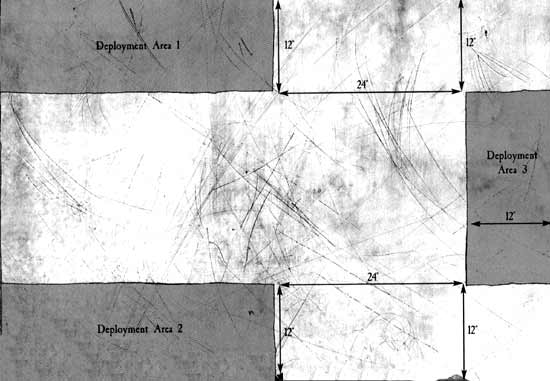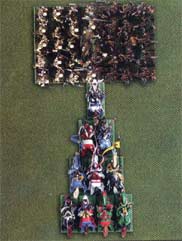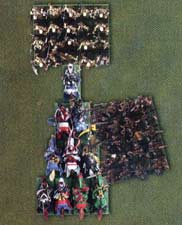| Overview: What follows is a generic scenario for a battle fought by three armies. In theory the armies are there to destroy all the enemies on the battlefield in a 'last one standing' situation, but players might wish to allow temporary alliances. Be warned though; if you start putting diplomacy into the game you risk really upsetting people! Armies: Armies are chosen using the Warhammer army lists to an agreed points value. Battlefield: Lay out the terrain in any mutually agreeable manner. 1. The three players roll off and the highest scoring player gets to choose in which area he wants to deploy his army (re-roll ties). Then the remaining two players roll off again and the second winner chooses his deployment zone, leaving the last to his opponent. 2. Armies are deployed in the deployment zones shown on the map below. The players take it in turns to choose and deploy one unit at a time in the following order: area 1, area 2, area 3. All war machines in a player's army are deployed at the same time, although they can be deployed in different parts of the deployment area. All characters in an army are deployed after all other units, all at the same time. 
3. Scouting units are not deployed with the rest of the units. Instead they are placed on the table after all units in both armies have been deployed, as described in the rules for Scouts on page 112 of the Warhammer rulebook. Who goes first? At the beginning of each turn, the three players roll off and the highest scoring player gets to choose in which position to play -first, second or third (re-roll ties). Then the remaining two players roll off again and the second winner chooses his position, excluding of course the one already chosen by the first player, leaving the last available position to his opponent. Once the order of play has been established, players take their turns as normal. The above procedure is repeated at the beginning of each following turn. The only exception is that a player can never take two turns in a row, so the player who moved last in a turn cannot choose in the following turn to move first if he wins the roll. Length of game: The game lasts eight turns or until two players concede defeat. All models in base contact with an enemy will fight in every player's Close Combat phase, regardless of whose turn it is. In a multiple combat involving units from all three sides, models can distribute their attacks freely among all enemy models they are in contact with. First work out each side's combat score as you would if the third party wasn't there. Then compare the three scores and apply all the relative results at the same time (see the examples on the next page). Solve fleeing and pursuing carefully, rolling a dice to determine which unit pursues first, because this can often generate new combats between units that were not fighting each other, but were in contact with a common enemy. These multiple fights will sometimes lead to very messy situations, where the players will need to use their common sense and the guidance offered by the examples to reach a solution. The player whose turn it is receives his power dice as normal and the other players, receive their Dispel dice. For this scenario, the basic number of Dispel dice received by players is only one instead of two as long as there still are more than two players, otherwise it reverts to normal. Spells are cast as normal. If a spell is targeted at troops belonging to a single enemy, only that player can try and dispel them. If the spell is not targeted at an enemy or can potentially affect more than one enemy at the same time, both enemies secretly write down the number of Dispel dice they intend to use and then reveal them simultaneously. The player with the highest number of dice gets to roll them, the one with fewest dice keeps his dice. Players can also write that they wish to use a Dispel scroll (or similar one-shot dispelling item). A player using a scroll always counts as using a higher number of dice than a player dispelling normally with dice. If both players have bid the same number of dice or wish to use a scroll, they must roll off and the loser must use his scroll/dice to dispel. Unless two players concede, the winner is the player who scores the must Victory points. Victory points are awarded as follows: 1. When a unit/character/monstrous mount is destroyed (wiped out by magic/missile fire/close combat or run down by pursuers), the player who destroyed it scores Victory points equal to the unit's points value. Points scored in this way must be recorded immediately on a sheet of paper. In a multiple fight, troops belonging to two players may destroy one or more units from a third party in the same Close Combat phase. In this case the two players share the Victory points equally. 2. Killing an enemy General is worth an extra 100 Victory points - record them immediately. 3. Each enemy banner (units' banners and battle Standards) captured at the end of the game is worth an extra 100 points. It is vital that players use the Standard Bearer models to represent where the captured banners are, since they can be recaptured and, in this scenario, captured by a third party if the unit carrying them is defeated.
Undead vs Skaven: The Skaven kill three Skeletons, claim three ranks, one banner and a higher Unit Strength. The Undead kill one Skaven and claim three ranks and one banner. The Skaven win by three. Bretonnia vs Undead: The Bretonnians kill three Skeletons, and claim two ranks, one banner, flank attack and a higher Unit Strength. The Undead claim zero ranks (charged in the flank) and one banner, causing no wounds. Brettommia wins by seven. Bretonnia vs Skaven: The Bretonnians kill two Skaven and claim two ranks, one banner, flank attack and a higher Unit Strength. The Skaven kill one Bretonnian and claim zero ranks (charged in the flank) and one banner. Bretonnia wins by five. Overall result: The Undead lose ten extra Skeletons (7 against Bretonnia and 3 against the Skaven). The Skaven take a Break test on -5, fail it and run. The Bretonnians cannot pursue because they are still locked in combat with the Undead. The Bretonnians are locked in combat with the Undead from previous turns. The Skkven decide to charge them (note that they could have decided to charge both enemy units). Bretonnia vs Skaven: The Skaven kill two Bretonnians and claim three ranks, one banner and a higher Unit Strength. The Bretonnians kill one Skaven and claim two ranks and one banner. The Skaven win by three. Bretonnia vs Undead: The Bretonnians kill three Skeletons, and claim two ranks and one banner. The Undead kill none of the Bretonnians, and claim three ranks, one banner and a higher Unit Strength. The Bretonnians win by one. Undead vs Skaven: No fighting occurs. Overall result: The Undead lose one extra Skeleton (against Bretonnia) and stay in place. The Bretonnians take a Break test on -3 and fail. They run, and the Skaven pursue them. Note that the Undead cannot pursue them because they did not win the combat.
|

